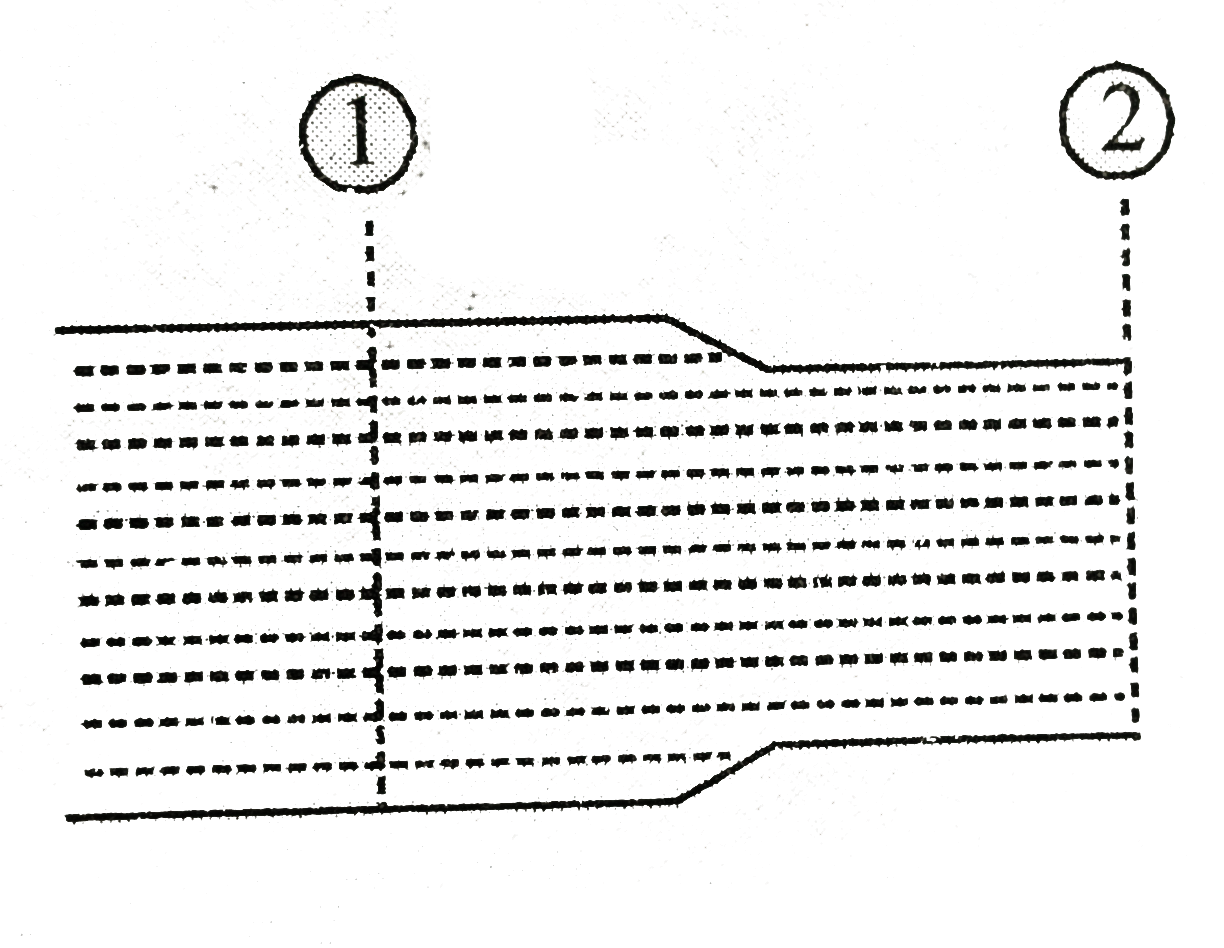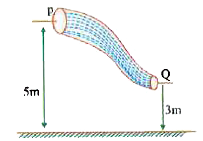A pipe of non uniform cross section has two distinct section and with areas and respectively. If the velocity of flowing liquid at section is , determine the velocity at section .
The correct Answer is:D
To solve the problem, we will use the principle of continuity in fluid mechanics, which states that the product of the cross-sectional area (A) and the velocity (V) of a fluid is constant along a streamline. This can be expressed mathematically as:
A1V1=A2V2
Where:
- A1 = cross-sectional area at section 1
- V1 = velocity at section 1
- A2 = cross-sectional area at section 2
- V2 = velocity at section 2
1. Identify the given values:
- Area at section 1, A1=2cm2
- Velocity at section 1, V1=5cm/s
- Area at section 2, A2=4cm2
2. Write the equation of continuity:
A1V1=A2V2
3. Substitute the known values into the equation:
2cm2×5cm/s=4cm2×V2
4. Calculate the left-hand side:
10cm3/s=4cm2×V2
5. Solve for V2:
V2=10cm3/s4cm2=2.5cm/s
6. Conclusion:
The velocity at section 2, V2, is 2.5cm/s.
- A1 = cross-sectional area at section 1
- V1 = velocity at section 1
- A2 = cross-sectional area at section 2
- V2 = velocity at section 2
- Area at section 1, A1=2cm2
- Velocity at section 1, V1=5cm/s
- Area at section 2, A2=4cm2
A1V1=A2V2
2cm2×5cm/s=4cm2×V2
10cm3/s=4cm2×V2
V2=10cm3/s4cm2=2.5cm/s
The velocity at section 2, V2, is 2.5cm/s.
Topper's Solved these Questions
- BOOK - CENGAGE PHYSICSCHAPTER - FLUID MECHANICSEXERCISE - Solved Examples7videos
FLUID MECHANICS
- BOOK - CENGAGE PHYSICSCHAPTER - FLUID MECHANICSEXERCISE - Exercise 4.111videos
FLUID MECHANICS
- BOOK - CENGAGE PHYSICSCHAPTER - DIMENSIONS & MEASUREMENTEXERCISE - Integer2videos
DIMENSIONS & MEASUREMENT
- BOOK - CENGAGE PHYSICSCHAPTER - GRAVITATIONEXERCISE - INTEGER_TYPE1videos
GRAVITATION
Similar Questions
A horizontal pipe of varying cross-sectional area carries water flowing at a constant rate. The pressure at sections (1) and (2) are 50cm and 20cm of Hg. If the velocity of section (1) is 5m/s, what is the velocity of section (2). Also determine the ratio of 4 areas at sections (1) and (2) (as shown in Fig.
 View Solution
View SolutionAn ideal fluid flows through a pipe of circular cross section made of two sections with diameters 2.5 cm and 3.75 cm. The ratio of the velocities in the two pipes is
View Solution
Knowledge Check
- Question 1 - Select One
A non-viscous fluid of constant density of 1000kg/m3 flows in stream line motion along a tube of variable cross-section
 The area of cross-section at two P and Q at lengths 5m are 40cm2and20cm2 respectively. If velocity of fluid at P is 3m/s then find velocity of fluid at Q.A3m/sB4m/sC5m/sD6m/s
The area of cross-section at two P and Q at lengths 5m are 40cm2and20cm2 respectively. If velocity of fluid at P is 3m/s then find velocity of fluid at Q.A3m/sB4m/sC5m/sD6m/s - Question 2 - Select One
Water flows through a non-uniform tube of area of cross section A, B and C whose values are 25, 15 and 35cm2 resprectively. The ratio of the velocities of water at the sections A,B and C is
A5:3:7B7:3:5C21:35:15D1:1:1 - Question 3 - Select One
An ideal fluid flows through a pipe of circular cross section made of two section with diamters 2.5 cm and 9.76 cm. The ratio of the velocities in the two pipes is
A9:4B3:2C√3:√2D√2:√3
An ideal liquid flowing through a pipe A of cross-section 0.2m2 with velocity 10ms enters a T-junction. One side of the T-junction B has cross-section area 0.1m2 and the other side C has cross-section area 0.05m2. If the velocity of water is C is 15ms then in B the velocity is
View SolutionAn ideal fluid flows through a pipe of circular cross-section made of two sections with diameters 2.5cm and 3.75cm. The ratio of the velocities in the two pipes is
View SolutionAn ideal fluid through a pipe of circular cross-section made of two sections with diameters 2.5cm and 3.75cm. The ratio of the velocities in the two pipes is
View SolutionWater is flowing steadily through a horizontal pipe of non - uniform cross - section . If the velocity of water cross - section is 0.02m2 is 2m/s , what is the velocity of water at another point where the cross - section is 0.01m2 ?
View SolutionA liquid flows through a horizontal tube. The velocities of the liquid in the two sections, which have areas of cross section A1 and A2 are v1 and v2 respectively. The difference in the levels of the liquid in the two vertical tubes is h. Then
 View Solution
View Solution

